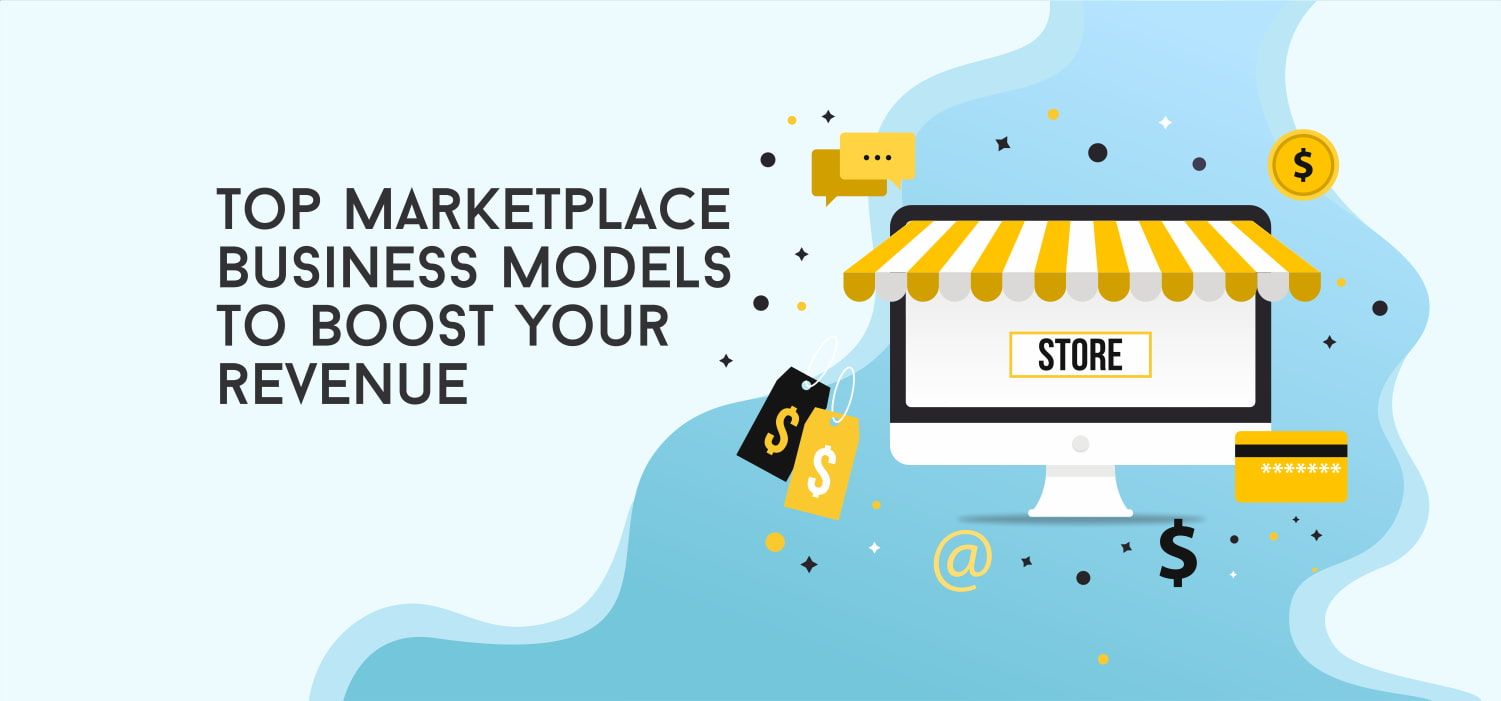So, you decide to start an online marketplace. Nevertheless, have you thought about how your business would make money? Would it be a subscription, commission or lead generation model?
In fact, marketplace businesses are long-term initiatives. Therefore, in order to build a successful marketplace platform, you need to find a suitable revenue model that will finance its operations. In reality, most startups fail due to choosing the wrong business model - the model that does not scale to ensure long term sustainability.
Our team would like to shed light on the several revenue models that most online marketplace businesses use. The reviewed models are quite universal and would fit for all marketplaces (both product and service-oriented), therefore, you can choose the right marketplace business model for your idea.
It is necessary to mention that as examples we choose top marketplaces, such as Amazon, eBay, Etsy, etc.. However, the mentioned marketplaces were able to incorporate several models in their business practice through years. For the sake of the article’s topic, we mentioned only relevant examples to the precise monetization model with the focus on the supplier - marketplace interaction and monetization requirements.
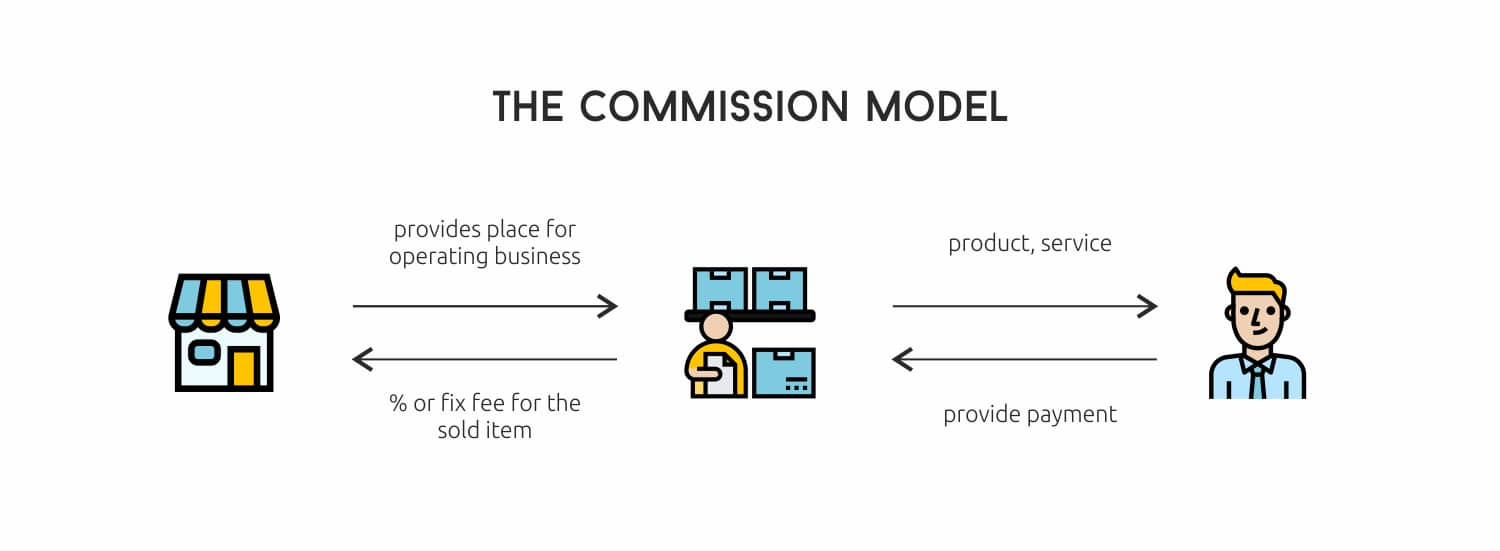
The Commission Model
This is the most popular online marketplace business model which is suitable for both startups and established brands. The system is quite easy to understand and implement. The fee is charging for each transaction in a look of percentage or a fixed fee for each sold item. Moreover, the platform might charge either the seller or the buyer, or take a commission from both of them. The best-known marketplace platforms that use commission monetization are Airbnb, Etsy, eBay, Fiverr, TaskRabbit and Uber.
This model is quite attractive to suppliers since they are not charged anything before they get some value from the marketplace. In addition, the main advantage of the commission model is that it scales perfectly, which means that the higher the value of the items sold on the marketplace, the higher the revenue for the marketplace itself.
On the other hand, one of the main challenges of this business model is setting the right price. Will it be a percentage or a fixed fee? How big should the commission be? Will you charge only one party of the deal or both? These and other similar questions would depend on whether the marketplace is a seller- or buyer-oriented.
How It Works:
The more complicated structure was incorporated by Amazon - eCommerce platform where various products from Amazon and third parties are sold to users all around the world. The primary source of revenue for Amazon is the commissions and fees that it obtains by making the borrowers and sellers meet. Amazon doesn’t sell a lot of stuff on its own. It just provides a marketplace guaranteeing a standardized experience for both the buyers as well as the sellers.
If you want to sell on Amazon you need to be familiar with two programs that are available. The first one, Amazon Vendor Central grants the platform the right of the supplier's inventory. In this case, the supplier sells the inventory to Amazon at wholesale rates. Once those items have been sent to Amazon, the seller is done with the products. Amazon pays for the inventory directly to the seller and maintains ownership of the products. Amazon sells those products in the marketplace - choosing their own price and shipping options.
The other program is Amazon Seller Central which remain, sellers, the ownership of their inventory and sell under their own brand name. The mechanism works this way: sellers list their products on the Amazon marketplace and sell goods as 3rd party sellers. In this way, sellers are able to control shipping and prices. Currently, more than half of the total sales on Amazon come from third-party sellers.
Third parties can sell on Amazon as Individual or Professional Sellers. The Professional selling plan is available for a $39.99 monthly subscription fee plus per-item selling fees, which vary by category. If you plan to sell fewer than 40 items a month, the Individual plan may be best for you. There is no monthly subscription fee. Instead, Individuals pay $0.99 per item sold plus other selling fees (from $0.45 to $1.35), which vary by category. When your item sells, Amazon collects the amount paid by the buyer (including the item price and any shipping, gift wrap, or other charges).
Sellers pay the greater of the category-specific referral fee or per-item minimum referral fee. The first is usually 15% of the sale price, while the minimum referral fee can be $0, $1 or $2.
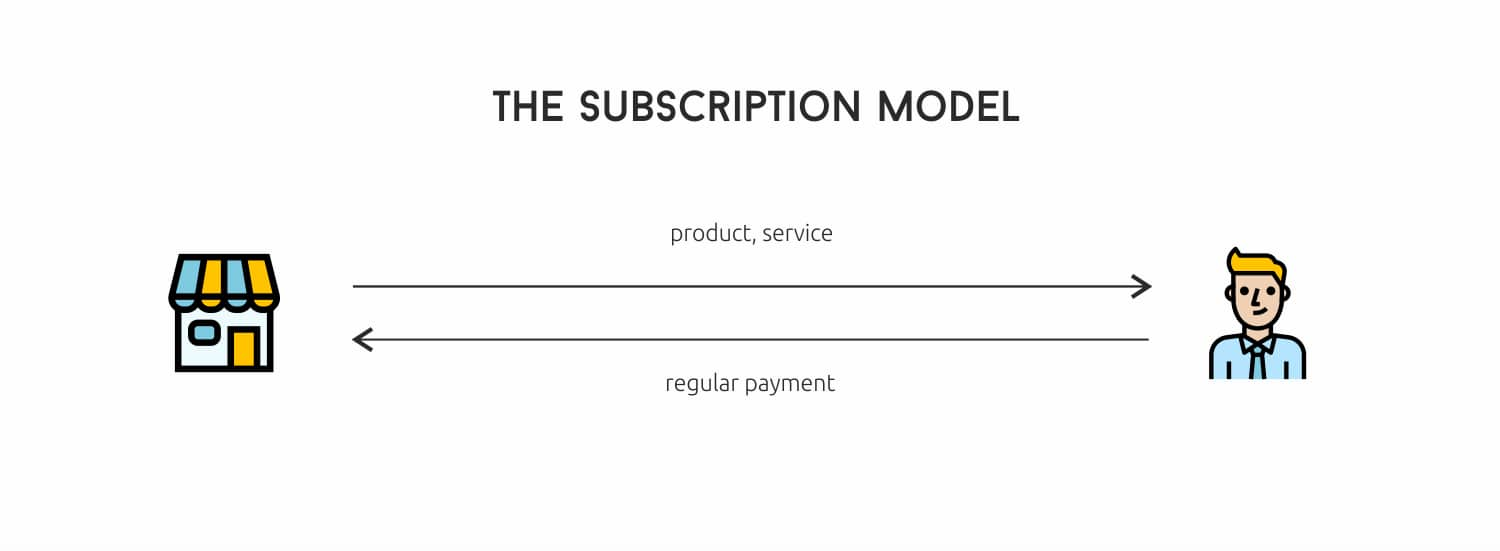
The Subscription Model
This model suggests that in order to get access to the platform, the user needs to pay regular fees. The purpose of the subscription model might be helping the suppliers to find new clients, while for customers it helps them save costs or find unique experiences. The subscription model is a good choice if the value of the provided product or service is high. The brands that benefit from this model are HomeExchange, LinkedIn, YouTube, Netflix, etc..
The main advantage of this model is that it guarantees revenue regardless of whether the transaction is completed. It includes monthly or yearly fees for a certain set of features. Besides, if new sellers want to get access to superior benefits, they should pay a membership fee, too. On the other hand, this model restricts the vendor capabilities and there might be a challenge to choose which plan to implement.
How It Works:
Along with the commission model and listing fee, the marketplace giant eBay has introduced the subscription fee for sellers. They have earned the confidence of their vendors to implement different subscription plans along with other revenue streams. eBay is pretty clear in limiting or providing additional ben vendors’ role in their subscription model.
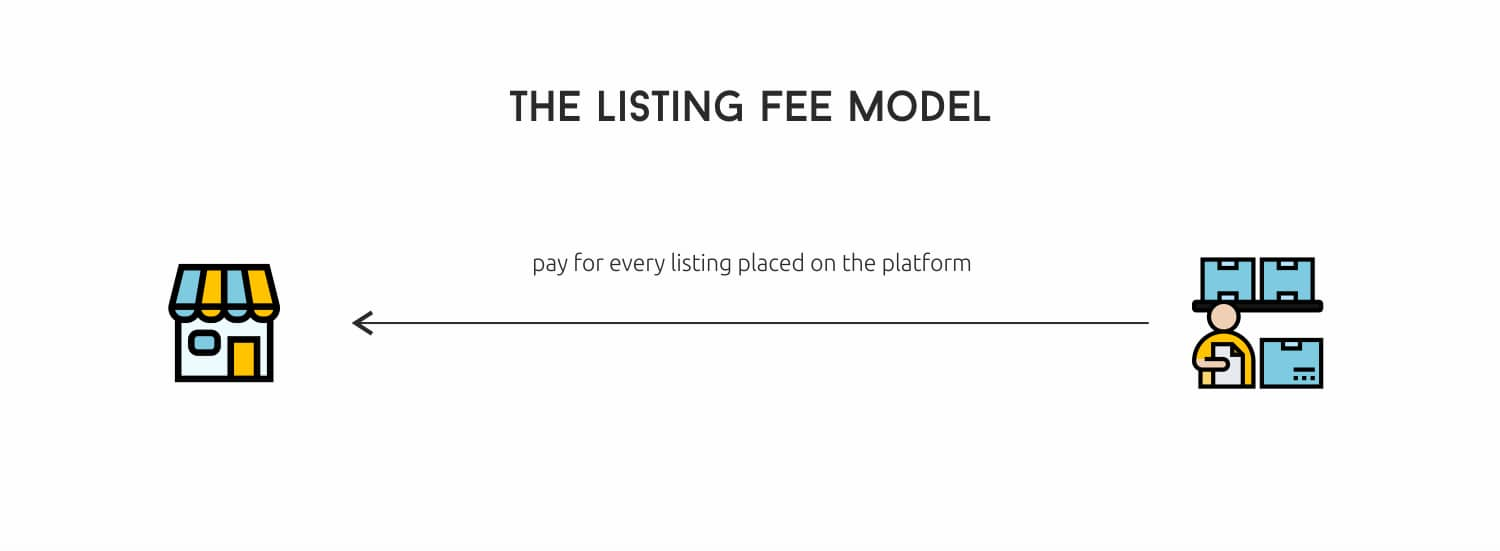
The Listing Fee Model
According to this model, sellers are charged to list on the marketplace. The listing fee model often helps ensure a higher quality of products being displayed on the marketplace. This is because sellers are forced to be more selective about which products they insert and will usually choose their best-performing ones.
How It Works:
Etsy is an example of a B2C marketplace that uses the commission model but also charges a fee to post new listings. Etsy charges $0.20 to list items on its platform. Apart from the listing fee, Etsy also charges sellers a commission for every sale. The commission fee has been fixed at 3.5%. Sellers have the option to set their own sale price but Etsy cuts a commission of 3.5% from the sale price before paying the money to the seller. Etsy has given some special features to sellers which they can avail by paying an extra cost. These are basically advertising options like making a product as featured product etc. Sellers can showcase their shops and hence have more sales.
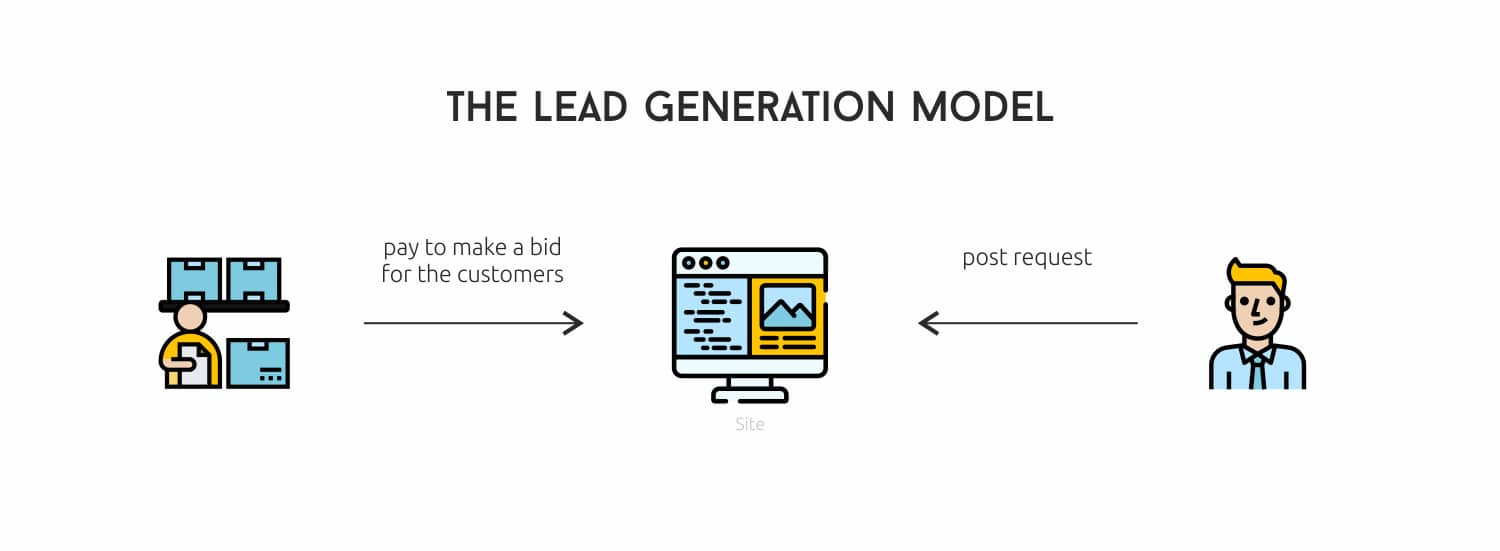
The Lead Generation Model
This model is a sort of mixture between commission and listing fee models. The lead generation model suggests that customers post requests on the site while suppliers pay in order to make a bid for these customers. This revenue model only works when the value of a lead is high, so this model is perfect for B2B or B2C marketplaces. If properly implemented, the amount of the lead fee can be higher than a listing or membership fee due to the long-term value derived from each new relationship.
When transactions take place outside the platform, lead fees may be the right solution for you. It means that your buyers have to pay to get access to detailed information about the item they are interested in. Thus, your marketplace leads the performer to a potential buyer. Lead fees can help you if you are going to build an online marketplace that offers non-standard goods or services, including cleaning, design service, music teaching, dating sites, and others.
The platforms which are using the lead-generation model in their business include ProReferral, Zaarly, Bidvine, etc.
How It Works:
Thumbtack is the platform where you can find local professionals. Thumbtack has a multisided business model, with two independent customer segments that are both needed in order to operate in the process. Additionally, there are several types of leads that eventually influence the financial aspect.
Exact match is when a customer reaches out to a tasker about a job that perfectly matches your targeting preferences. A tasker pays for these leads automatically and gets a 20% discount. Partial match is when a customer reaches out to a tasker about a job that matches some (but not all) of the targeting preferences. In this case, a tasker can either decline (he will not be charged in this way) or accept and pay for the lead at full price. Other opportunities mean that if a tasker wants more work, he looks for opportunities in the Jobs tab. These customers already reached out to other pros. A tasker can still let the customer know that he is interested in case the other pros can’t do the job. Keep in mind, if that customer messages a tasker back, he pays full price for the lead.
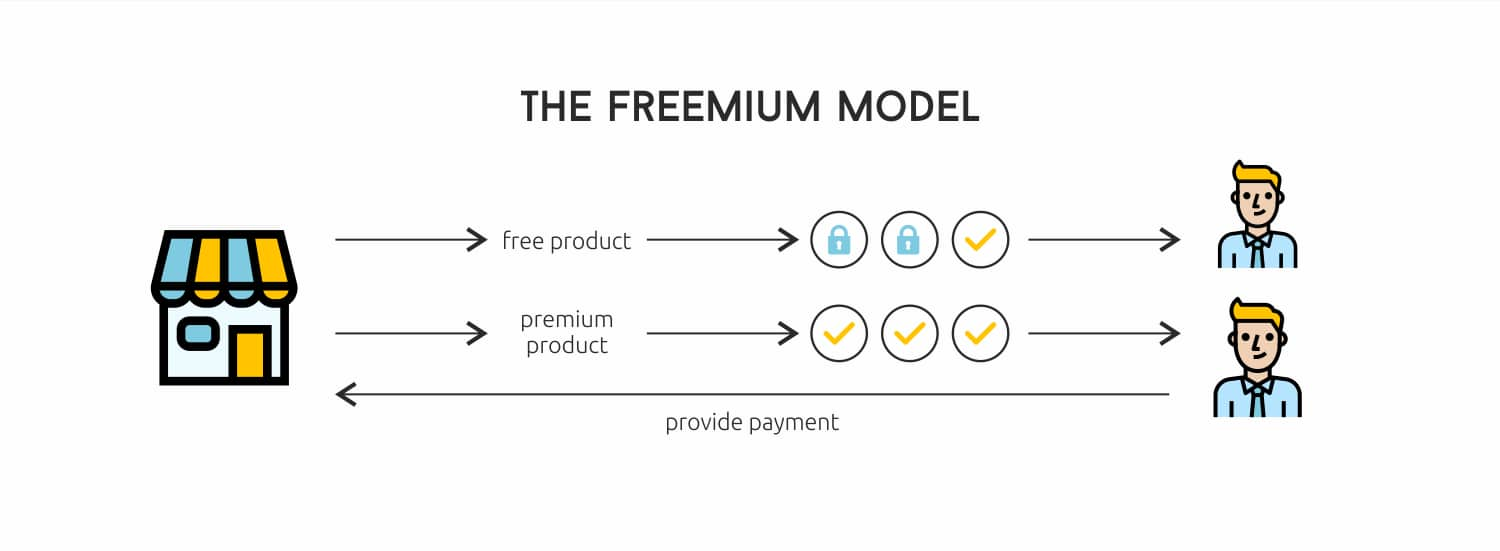
The Freemium Model
The freemium business model is where users get the basic products or services for free but must pay for a premium version with additional features. Zapier, TuneIn and Evernote are using the Freemium system. With a smart freemium business model, it can help drive massive traffic to companies’ websites. Offering “try before you buy” experience is the right way to prove your niche expertise and allow test your products.
Freemium works in a marketplace when the platform provides value-added services in addition to basic transactions or features. Basic transactions in a freemium marketplace generally don’t entail costs for the buyer or seller. However, if either party wants additional value, such as insurance or delivery services, the platform charges a premium. The challenge is to find a service that is valuable enough that people are willing to pay for it, but not so crucial that the transaction is pointless without it. If the platform charges for crucial aspects of the transaction while advertising that such transactions are “free,” it can alienate users.
How It Works:
Spotify is an app for consumers to stream their favorite music from their phone or computer. Spotify operates under a freemium business model (basic services are free, while additional features are offered via paid subscriptions). Spotify generates revenues by selling premium streaming subscriptions to users and advertising placements to third parties.
The free plan lets users stream most albums, playlists, or curated radio stations on shuffle play, but they are served ads in between songs and users can't skip to specific songs they like. On the other hand, the Premium plan level affords users a much deeper set of features for a richer experience. Premium users have access to things like access to offline playlists, improved sound quality for music streaming, individual track selection, etc..
Conclusion
Once you’ve decided to build a marketplace you need to think through the business model of your next project. It is quite a crucial step in the new project development since the revenue model will determine the profitability of your product as well as customer satisfaction. In the article, we discussed the top marketplace, business models: commission, subscription, listing fee, lead generation and freemium models. There are no good or bad models, so you have to think carefully and evaluate every aspect of the models to choose the most suitable one for your business.
We hope that the article will be helpful for you, but in case you still have any questions and suggestions feel free to contact us and we gladly assist you in any inqueries.
